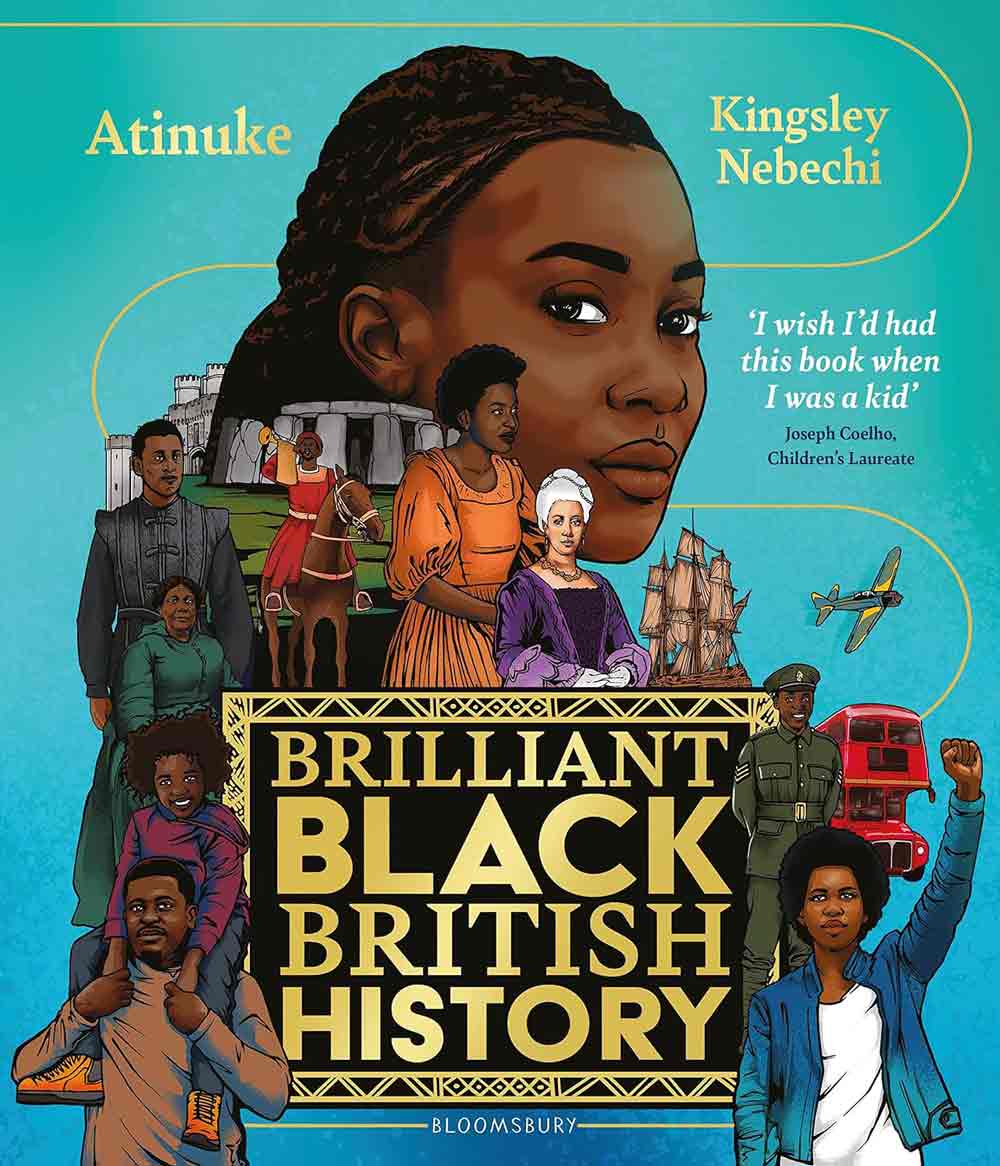 Showcased in an exhibition in the Black Cultural Archives in Windrush Square, Brilliant Black British History written by Atinuke and illustrated by Kingsley Nebechi, is first and foremost a book for children about the place of Black people in the this country’s history. Beginning over 10,000 years ago with Cheddar Gorge man (who was black) and ending with the Black Lives Matter Movement(BLM), the book charts how black people have been part of British history since it began. From prehistory, through Roman Britain, the middle ages, the Tudors, Stuarts, Georgians and Victorians and into the present day, the book highlights both how Black people have contributed to Britain’s development and success, while also suffering the cruelty and injustice of the slave trade, colonialism and racism.
Showcased in an exhibition in the Black Cultural Archives in Windrush Square, Brilliant Black British History written by Atinuke and illustrated by Kingsley Nebechi, is first and foremost a book for children about the place of Black people in the this country’s history. Beginning over 10,000 years ago with Cheddar Gorge man (who was black) and ending with the Black Lives Matter Movement(BLM), the book charts how black people have been part of British history since it began. From prehistory, through Roman Britain, the middle ages, the Tudors, Stuarts, Georgians and Victorians and into the present day, the book highlights both how Black people have contributed to Britain’s development and success, while also suffering the cruelty and injustice of the slave trade, colonialism and racism.
Leslie Manasseh talked to Atinuke and Kingsley about their book. Atinuke explained how it came about: “It was 2020, a time of the BLM marches. It felt like a new conversation had opened up….we were given permission to talk about race and racism. I wanted to provide teachers with a list of books about Black British history, because it was not part of the curriculum. I was very naive! Because I discovered that there was no children’s book that focused on our history. So I decided to write one! It’s for everybody. I wanted it to be a children’s book, a resource for teachers but also for anybody curious about Black British history.
“It was very difficult choosing what to write about. It needed to be child friendly so I left out a lot of horrific details – rape and torture for example. I also focussed on what I thought children would find interesting – for example a black man emperor. I did say that the people trafficked were worked to death so I don’t make it rosy but I wanted to avoid too much trauma. But how can you write about Black history without pointing out that people are killed because of their colour?”
Indeed it is a book which does not pull its punches. This, in relation to the British Empire: “in every country that Britain colonised the same things happened: the people whose country it was were either killed, driven away or forced to work and pay taxes to the British. The British took their land, their freedom and their riches”.
The book is lavishly illustrated – it’s a pictorial history alongside a written one and the way the images sit with the text reflects Kingsley’s background in graphic design. I asked about the challenges of illustrating for children what were often traumatic events.
He talked about “reading the illustrations….My approach is to tell someone else’s story – a visual journey with images to explain the words so the reader can understand the atmosphere, the mood and what is happening to people. The events were horrific but the people were beautiful. I didn’t not want reading the book to be a sad experience all the way through. Visual tone is important but the theme is beautiful people going through horrible things – which still happens today”.
I asked about the process of distilling and condensing such a huge subject and talked in particular about how the book dealt with slavery and the economic impact of colonialism. Atinuke explained “I didn’t want to refer to people as being slaves because it implies something intrinsic about the person. I do use “enslaved” but not much. I prefer talk about stolen people whose lives were stolen from them. They were stolen from their families and their homes and they were forced to work for free and because slaves weren’t paid, the money went instead to Britain. I mention that stolen people were now free but with no money, no land and no help, many black communities and countries are poor to this day. I say something similar when I talk about independence – countries that were colonised, but there were no reparations for things stolen.”
While much of the history of Black people in Britain is one of trauma and injustice, Atinuke and Kingsley also focussed on positive messages and lessons.
“What gave me hope when writing the book was the people themselves. Realising that people who were enslaved – their resilience and their dignity and strength. The fact that they survived that experience. The fact that generation after generation kept fighting”
The book also tells the story of inspirational black individuals “People like Queen Charlotte (a woman of African ancestry who married George III) inspired me — she lived in a racist environment and when her husband was ill she ruled the country and was known as a good ruler. I thought of the courage and dignity it takes to live in a hostile environment and still rule, and not give in to despair and hopelessness.
Brilliant Black British History is a history book and a teaching resource. It is simply but clearly written and beautifully and powerfully illustrated. But it is also a call to action. It does not pretend to be a dispassionate exposition and explanation of distant events, but rather a close-up journey of trauma, injustice, human resilience and heroism that continues today. It means to write into British history, the lives and achievements of the very many Black people who have too often been written out. And its final words are “What will you do?”
The exhibition runs in BCA, Windrush Square until 28 January 2024. It takes you through the main historical periods in the book with the help of QR codes.
Opening Times: Thursdays – Saturdays: 10:00–18:00, Sundays: 12:00 –17:00
Entry is free
Brilliant Black British History is published by Bloomsbury Children’s Books and is on sale for £12.99






